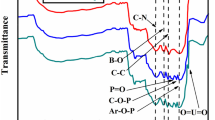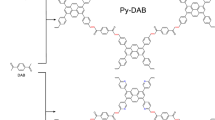Abstract
With the rapid development of the nuclear resource industry, the development of high-efficiency adsorbents is the key to the separation and removal of uranium from aqueous solutions. In this paper, phenyl phosphonic acid was designed as a functional monomer, the aromatic building blocks such as benzene and triptycene as an external crosslinker. Through the “knitting” strategy, a novel phosphonic acid-based functionalized triptycene-based hyper-crosslinked porous polymer (TPP-BPP) and benzene-based hyper-crosslinked porous polymer (B-BPP) were prepared by the above monomer and crosslinker. The resulting polymer B-BPP has a much higher surface area (SBET = 836.21 m2/g) than that of polymer TPP-BPP (SBET = 30.60 m2/g) due to the large skeleton triptycene confines the void. Owing to a large number of phosphonic acid functional groups, the polymer TPP-BPP and B-BPP both have a good ability to remove uranium. The optimal adsorption pH is 7 and the adsorption time is 90 min. Under the best experimental conditions, the maximum adsorption capacity of TPP-BPP for uranium is 119.05 mg/g, and the maximum adsorption capacity of B-BPP for uranium is 222.72 mg/g. Furthermore, in the presence of coexisting ions Na+, Mg2+, Al3+, Co2+, Ni2+, NO3−, CO32−etc., they still have good selectivity to uranium ascribed to the strong complexation between UO22+ and P=O groups anchored on the polymer, which was evidenced by experimental results. Also, it has good reusability and can still maintain a very high removal percentage after at least being recycled five times. Therefore, the convenient synthesis route for the novel phosphonic acid-based functionalized hyper-crosslinked porous polymer has a promising application prospect for uranium adsorption.
Graphical abstract










Similar content being viewed by others
References
Aixia Z, Jinsheng W (2018) Recovery of U(VI) from simulated wastewater with thermally modified palygorskite beads. J Radioanal Nucl Chem 318:1119–1129
Zhou L, Shang C, Liu Z (2012) Selective adsorption of uranium (VI) from aqueous solutions using the ion-imprinted magnetic chitosan resins. J Colloid Interface 366(1):165–172
Feng J, Yang Z, He S (2018) Photocatalytic reduction of Uranium(VI) under visible light with Sn-doped In2S3 microspheres. Chemosphere 212(12):114–123
Orabi AH, Abdelhamid AE, Salem HM (2021) Uranium removal using composite membranes incorporated with chitosan grafted phenylenediamine from liquid waste solution. J Cellulose 2:1–19
Orabi AH, Abdelhamid AES, Salem HM (2020) New adsorptive composite membrane from recycled acrylic fibers and Sargassum dentifolium marine algae for uranium and thorium removal from liquid waste solution. J Radioanal Nucl Chem 326:1233–1247
Duquène L, Tack F, Meers E (2008) Effect of biodegradable amendments on uranium solubility in contaminated soils. J Sci Total Environ 391:26–33
Nidheesh PV, Zhou M, Oturan MA (2018) An overview on the removal of synthetic dyes from water by electrochemical advanced oxidation processes. Chemosphere 197:210–227
Zhao D, Yang S, Chen S (2011) Effect of pH, ionic strength and humic substances on the adsorption of Uranium (VI) onto Na-rectorite. J Radioanal Nucl Chem 287(2):557–565
Zhang S, Yuan D, Zhao J (2021) Highly efficient extraction of uranium from strong HNO3 media achieved on phosphine oxide functionalized superparamagnetic composite polymer microspheres. J Mater Chem A 9:18393–18405
Ahmad M, Chen J, Yang K (2021) Preparation of amidoxime modified porous organic polymer flowers for selective uranium recovery from seawater. Chem Eng J 418(23):129370–129377
Arica MY, Bayramoglu G (2016) Polyaniline coated magnetic carboxymethylcellulose beads for selective removal of uranium ions from aqueous solution. J Radioanal Nucl Chem 310:711–724
Gba B, Mya A (2019) Star type polymer grafted and polyamidoxime modified silica coated-magnetic particles for adsorption of U(VI) ions from solution—ScienceDirect[J]. Chem Eng Res Des 147:146–159
Bayramoglu G, Arica MY (2017) Polyethylenimine and tris(2-aminoethyl)amine modified p(GA–EGMA) microbeads for sorption of uranium ions: equilibrium, kinetic and thermodynamic studies. J Radioanal Nucl Chem 312:293–303
Şimşek S, Kaya S, Şenol ZM (2022) Theoretical and experimental insights about the adsorption of uranyl ion on a new designed Vermiculite-Polymer composite. J J Mole Liq 352:118727
Şenol ZM, Şimşek S, Ulusoy Hİ (2020) Synthesis and characterization of a polyacrylamide-dolomite based new composite material for efficient removal of uranyl ions. J Radioanal Nucl Chem 324:317–330
Şenol ZM, Keskin ZS, Özer A (2022) Application of kaolinite-based composite as an adsorbent for removal of uranyl ions from aqueous solution: kinetics and equilibrium study. J Radioanal Nucl Chem 331:403–414
Celikbıcak O, Bayramoglu G, Acıkgoz-Erkaya I (2021) Aggrandizement of uranium (VI) removal performance of Lentinus concinnus biomass by attachment of 2,5-diaminobenzenesulfonic acid ligand. J Radioanal Nucl Chem 328:1085–1098
Tian K, Zhuang S, Wu J (2019) Metal organic framework (La-PDA) as an effective adsorbent for the removal of uranium (VI) from aqueous solution. Radiochim Acta 108(3):1–12
Ye H, Liu C, Wu MB (2022) Amyloid-like assembly converting commercial proteins to water-insoluble adsorbents with ultrahigh adsorption capacity and excellent antifouling property for uranium extraction. J Mater Chem A 10:2987–2994
Enol ZM, Keskin ZS, Zer A (2022) Application of kaolinite-based composite as an adsorbent for removal of uranyl ions from aqueous solution: kinetics and equilibrium study. J J Radioanalytical Nuclear Chem 331:403–414
Pandey P, Farha OK, Spokoyny AM (2011) A “click-based” porous organic polymer from tetrahedral building blocks. J Mater Chem 21(6):1700–1703
Yan H, Wenli B, Yingcen H, (2021) Efficient adsorption of methyl orange and methyl blue dyes by a novel triptycene-based hypercrosslinked porous polymer. RSC Adv, 5587–5594
Paul R, Shit SC, Singh A (2022) Organogel-assisted porous organic polymer embedding Cu NPs for selectivity control in the semi hydrogenation of alkynes. Nanoscale 14:1505–1519
Li B, Zhang Y, Ma D (2014) Mercury nano-trap for effective and efficient removal of mercury(II) from aqueous solution. Nat Commun 5:5531–5537
Huang L, Peng C, Cheng Q (2017) Thiol-functionalized magnetic porous organic polymers for highly efficient removal of mercury. Ind Eng Chem Res 56(46):13696–13703
Ravi S, Choi Y, Choe JK (2020) Achieving effective fructose-to-5-hydroxymethylfurfural conversion via facile synthesis of large surface phosphate-functionalized porous organic polymers. Appl Catal B 271:118942–118942
Wang H, Yuan H, Wang X (2020) Synthesis of amides-functionalized POPs-Supported Nano-Pd Catalysts for phosphine ligand-free heterogeneous hydroamino-carbonylation of alkynes. Adv Synth Catal 362(12):2348–2353
Yang S, Qian J, Kuang L (2017) Ion-imprinted mesoporous silica for selective removal of uranium from highly acidic and radioactive effluent. ACS Appl Mater Interfaces 9:29337–29344
Liang XT, Bien T (2017) Hypercrosslinked porous polymer materials: design, synthesis, and applications. Chem Soc Rev 46:322–3356
Duval CE, Hardy WA, Pellizzeri S, Devol TA (2019) Phosphonic acid and alkyl phosphate-derivatized resins for the simultaneous concentration and detection of uranium in environmental waters. J React Funct Polym 137:133–139
Sarafraz H, Minuchehr A, Alahyarizadeh G (2017) Synthesis of enhanced phosphonic functional groups mesoporous silica for uranium selective adsorption from aqueous solutions. J Sci Rep 7:11675
Diallo MS, Arasho W, Jr. JHJ (2008) Dendritic chelating agents. 2. U(VI) binding to poly(amidoamine) and poly(propyleneimine) dendrimers in aqueous solutions.[J]. Environ Sci Technol, 42: 1572–1579
Lang DU, Yu-Xiang LI, Xue MA (2015) Determination of micro uranium by arsenazo III spectrophotometry. J Metallurgical Anal 6:68–71
Yao-Guo LI, Yang X (2012) Determination of trace U by spectrophometry of DBS-Arsenazo. J World Nuclear Geosci
Rong L, Li Y, Zhang M (2018) Phosphate-based ultrahigh molecular weight polyethylene fibers for efficient removal of uranium from carbonate solution containing fluoride Ions[J]. Molecules 23:1245
He Y, Li H, Zhou L (2019) Removal of Methyl Orange from Aqueous Solutions by a Novel Hyper-Cross-Linked Aromatic Triazine Porous Polymer. J Acta Physico-Chimica Sinica 35(3):299–306
Şenol ZM, Şimşek S (2020) Equilibrium, kinetics and thermodynamics of Pb (II) ions from aqueous solution by adsorption onto chitosan-dolomite composite beads. J Int J Environ Anal Chem, 1–15
Haji M, Gonzalez J, Drysdale J (2018) The effects of protective shell enclosures on uranium adsorbing polymers. J Ind Eng Chem Res 57:15534–15541
Yan H, Xua T, Jun H (2017) Amine functionalized 3D porous organic polymer as an effective adsorbent for removing organic dyes and solvents. J RSC Adv 7:30500–30505
Şenol ZM, Gül ÜD, Gürkan R (2020) Bio-sorption of bisphenol a by the dried- and inactivated-lichen (Pseudoevernia furfuracea) biomass from aqueous solutions. J Environ Health Sci Eng 18:853–864
Şenol ZM (2020) Effective biosorption of Allura red dye from aqueous solutions by the dried-lichen (Pseudoevernia furfuracea) biomass. J Int J Environ Anal Chem, 1–15
Han R, Zou W, Wang Y (2007) Removal of uranium(VI) from aqueous solutions by manganese oxide coated zeolite: discussion of adsorption isotherms and pH effect. J Environ Radioact 93:127–143
Khan S, Anjum R, Bilal M (2021) Revealing chemical speciation behaviors in aqueous solutions for uranium (VI) and europium (III) adsorption on zeolite. J Environ Technol Innov 22:101503
Zhou L, Shang C, Liu Z (2012) Selective adsorption of uranium(VI) from aqueous solutions using the ion-imprinted magnetic chitosan resins. J Colloid Interface 366:165–172
Negm SH, Abd El-Hamid AAM, Gado MA (2019) Selective uranium adsorption using modified acrylamide resins. J J Radioanal Nuclear Chem 319:327–337
Gao J, Yuan Y, Yu Q et al (2020) Bio-inspired antibacterial cellulose paper-poly (amidoxime) composite hydrogel for highly efficient uranium (vi) capture from seawater. Chem Commun 56(28):3935–3938
Cheng H, Zeng K, Yu J (2013) Adsorption of uranium from aqueous solution by graphene oxide nanosheets supported on sepiolite. J Radioanal Nucl Chem 298(1):599–603
Cao Q, Liu Y, Wang C (2013) Phosphorus modified poly(styrene-co-divinylbenzene)-PAMAM chelating resin for the adsorption of uranium (VI) in aqueous. J Hazard Mater 263:311–321
Acknowledgements
Financial support for this work was provided by the National Science Foundation of China (21908022), the Jiangxi Provincial Natural Science Foundation (20202BAB213009), Jiangxi Provincial Key Innovation Project (202110405013), and the Scientific and Technical Project of the Educational Department in Jiangxi Province (GJJ18040303).
Author information
Authors and Affiliations
Corresponding authors
Additional information
Publisher's Note
Springer Nature remains neutral with regard to jurisdictional claims in published maps and institutional affiliations.
Supplementary Information
Below is the link to the electronic supplementary material.
Rights and permissions
About this article
Cite this article
He, Y., Bao, W., Li, B. et al. Highly efficient removal of uranium from aqueous solution by a novel robust phosphonic acid functionalized aromatic-based hyper-crosslinked porous polymer. J Radioanal Nucl Chem 331, 3745–3756 (2022). https://doi.org/10.1007/s10967-022-08395-x
Received:
Accepted:
Published:
Issue Date:
DOI: https://doi.org/10.1007/s10967-022-08395-x




